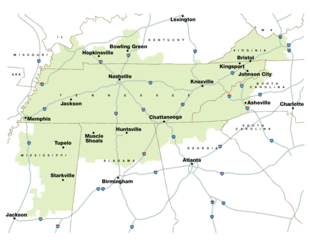
Back سلطة وادي تينيسي Arabic تنسی ولی آتوریتی AZB Tennessee Valley Authority Catalan Tennessee Valley Authority Danish Tennessee Valley Authority German Autoridad del Valle del Tennessee Spanish تنسی ولی آتوریتی Persian Tennessee Valley Authority French רשות עמק טנסי HE Tennessee Valley Authority Italian
 Logo of the TVA  Flag of the TVA | |
From top down and left to right: TVA's twin tower administrative headquarters in Knoxville, TVA's power operations headquarters in Chattanooga, and a map of TVA's service area | |
| Company type | State-owned enterprise |
|---|---|
| Industry | Electric utility |
| Founded | May 18, 1933 |
| Founders | |
| Headquarters | Knoxville, Tennessee, U.S. |
Key people | Joe Ritch, Chair[1] Jeff Lyash, CEO[2] |
| Revenue | |
| Owner | Federal government of the United States |
| Website | tva.com |
The Tennessee Valley Authority (TVA) is a federally owned electric utility corporation in the United States. TVA's service area covers all of Tennessee, portions of Alabama, Mississippi, and Kentucky, and small areas of Georgia, North Carolina, and Virginia. While owned by the federal government, TVA receives no taxpayer funding and operates similarly to a private for-profit company. It is headquartered in Knoxville, Tennessee, and is the sixth-largest power supplier and largest public utility in the country.[3][4]
The TVA was created by Congress in 1933 as part of President Franklin D. Roosevelt's New Deal. Its initial purpose was to provide navigation, flood control, electricity generation, fertilizer manufacturing, regional planning, and economic development to the Tennessee Valley, a region that had suffered from lack of infrastructure and even more extensive poverty during the Great Depression than other regions of the nation. TVA was envisioned both as a power supplier and a regional economic development agency that would work to help modernize the region's economy and society. It later evolved primarily into an electric utility.[5] It was the first large regional planning agency of the U.S. federal government, and remains the largest.
Under the leadership of David E. Lilienthal, the TVA also became the global model for the United States' later efforts to help modernize agrarian societies in the developing world.[6][7] The TVA historically has been documented as a success in its efforts to modernize the Tennessee Valley and helping to recruit new employment opportunities to the region. Historians have criticized its use of eminent domain and the displacement of over 125,000 Tennessee Valley residents to build the agency's infrastructure projects.[8][9][10]
- ^ "Board of Directors". TVA. Archived from the original on November 22, 2020. Retrieved November 25, 2020.
- ^ Gaines, Jim (February 14, 2019). "TVA names president of Canadian utility as new CEO to replace outgoing Bill Johnson". Knoxville News Sentinel. Knoxville, Tennessee. Archived from the original on April 11, 2020. Retrieved December 5, 2019.
- ^ Cite error: The named reference
reuters14was invoked but never defined (see the help page). - ^ Sainz, Adrian (November 14, 2019). "Nation's largest utility in long-term deals to sell power". ABC News. Associated Press. Archived from the original on July 9, 2021. Retrieved July 4, 2021.
- ^ Neuse 2004, pp. 972–979.
- ^ Ekbladh, David (Summer 2002). ""Mr. TVA": Grass-Roots Development, David Lilienthal, and the Rise and Fall of the Tennessee Valley Authority as a Symbol for U.S. Overseas Development, 1933–1973". Diplomatic History. 26 (3): 335–374. doi:10.1111/1467-7709.00315. ISSN 1467-7709. OCLC 772657716.
- ^ "Global Impact" (PDF). Tennessee Valley Authority. Archived (PDF) from the original on May 17, 2021. Retrieved May 17, 2021.
- ^ Cite error: The named reference
gaventawas invoked but never defined (see the help page). - ^ Cite error: The named reference
dispossessedwas invoked but never defined (see the help page). - ^ "The Price of Power: How the Tennessee Valley Authority Impacted Attitudes Towards Economic Development in East Tennessee". Appalachian Free Press. January 12, 2022. Archived from the original on February 18, 2022. Retrieved February 20, 2022.


